Mobile Ivy Bridge and ASUS N56VM Preview
by Jarred Walton on April 23, 2012 12:02 PM ESTIvy Bridge Application Performance: Movin’ On Up
We received our evaluation laptop exactly one week ago and have been feverishly running as many benchmarks as possible within the allotted time. Unfortunately, that means we can’t test everything, and one particular item we’d like to test is how the N56VM performs with a decent SSD in place of its mechanical hard drive. We’ll plan on swapping drives in the near future and will eventually list both HDD and SSD scores in Mobile Bench, but for now we’re running with the configuration Intel shipped us. We’ve also tested the N56VM with the integrated HD 4000 Graphics active as well as with the GT 630M—at least for benchmarks where the GPU can make a difference.
Trying to include all of the potentially meaningful comparisons for Ivy Bridge and Sandy Bridge is difficult, especially since we revamped our mobile test suite and added new tests after finishing some of the previous reviews. If you’d like to see more comparisons with our Ivy Bridge laptop and previous laptops, again we refer you to Mobile Bench. A few interesting comparisons you might enjoy are how Ivy Bridge stacks up against Dell’s XPS 15 L502x and XPS 15z, or AMD’s Llano A8-3500M test laptop.
For the charts throughout the remainder of this review, we’ve included a sampling of laptops where we were able to run most of our tests: besides the N56VM, we have the original Sandy Bridge i7-2820QM laptop, the ASUS K53E with dual-core i5-2520M (and no switchable graphics), and these recently reviewed laptops: the Razer Blade (a “gaming ultrabook”), Acer TimelineU (an ultrabook with NVIDIA’s new Kepler GPU), Sony VAIO SE (IPS display and HD 6630M switchable graphics), and Toshiba P775D (a last look at AMD’s Llano A8-3520M, just before Trinity hits the stage).
Since not all of the laptops are equipped with similar components, to better put things in perspective we’ve taken the original Sandy Bridge notebook that Intel shipped us and we installed a 640GB 5400RPM hard drive—the hard drive that was in the ASUS K53E (dual-core Sandy Bridge)—and we’ll add those scores where it matters. That will hopefully give us a good indication of the range of performance we can expect from Ivy Bridge laptops, depending on whether they have a hard drive, SSD, or HDD + SRT caching configuration. Note that for the benchmarks we’re running, the presence or lack of an SSD really only matters for PCMark 7 and Vantage, which is where we’ll start.
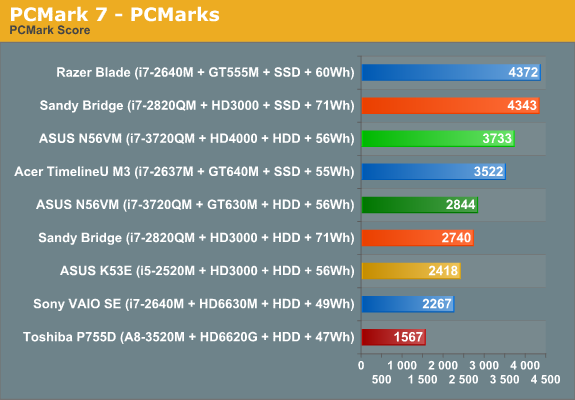
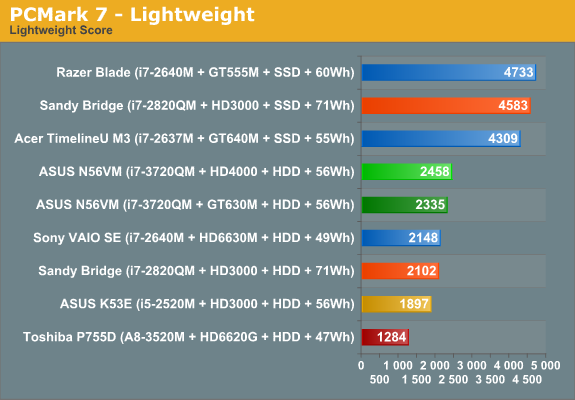

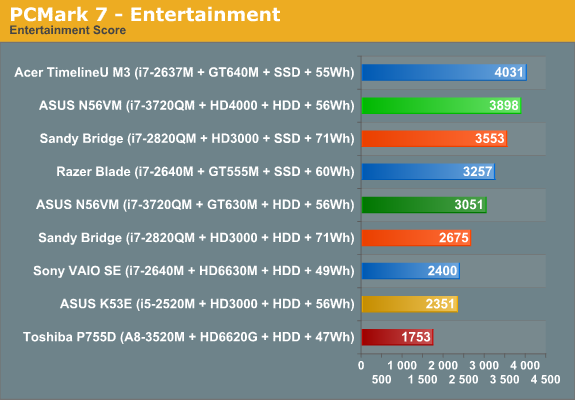
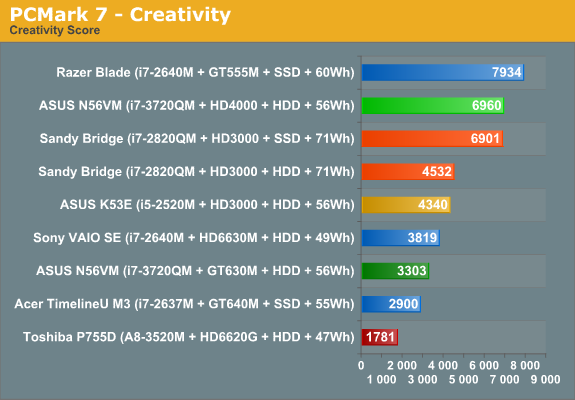
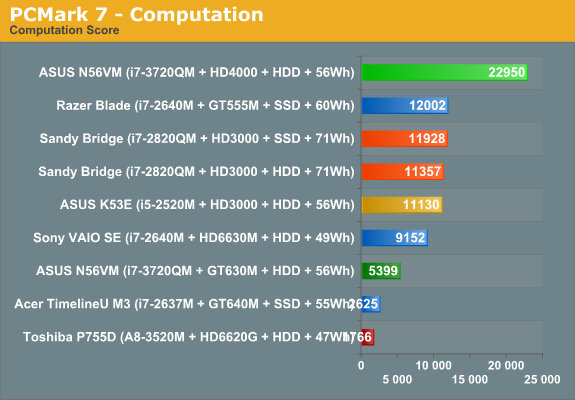
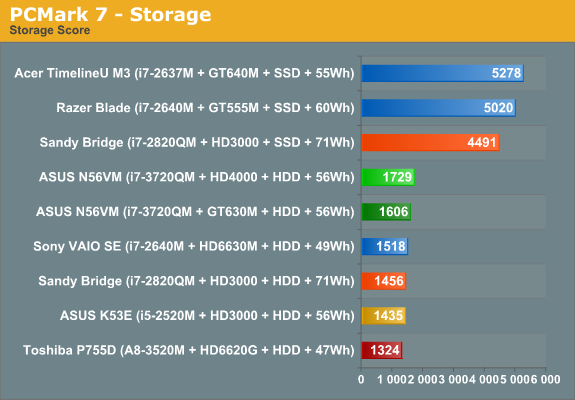
First things first, Intel’s IGP and Quick Sync can make a huge difference with PCMark 7—just take one look at the Computation score to see why. Interestingly enough, the HD 4000 actually outperforms the GT 630M in every single element of the PCMark 7 test suite, often by a fairly large margin. It’s not clear why the storage score in particular should differ by 8%, but that’s what we see. For the remaining tests, PCMark 7 is often simply an indicator of whether or not a system has an SSD, so let’s just focus on the Ivy Bridge vs. SNB+HDD comparisons.
Unfortunately, we didn’t have the time or hardware to use the same HDD in both Ivy Bridge and Sandy Bridge, so going from an Intel 160GB G2 SSD to a 5400RPM Seagate hard drive very likely takes us too far in the other direction. Outside of the computation test, the presence of an SSD catapults the Sandy Bridge performance up anywhere from 33% (Entertainment) to over 200% (Storage), with the Lightweight and Productivity scores more than doubling.
Given the storage-centric nature of PCMark 7, I’m not sure we can draw too much information from the charts, other than pointing out that Ivy Bridge does end up as the fastest HDD-equipped laptop we’ve tested in PCMark 7. As a quick gauge of general home and office use, PCMark 7 is at least useful, and the conclusion is that HD 4000 will handle such mundane tasks without difficulty, often delivering a better experience than what you’d get from a discrete GPU—especially if you happen to do any video transcoding. We’ll have more to say on that in a moment, but first here are the rest of our application results:
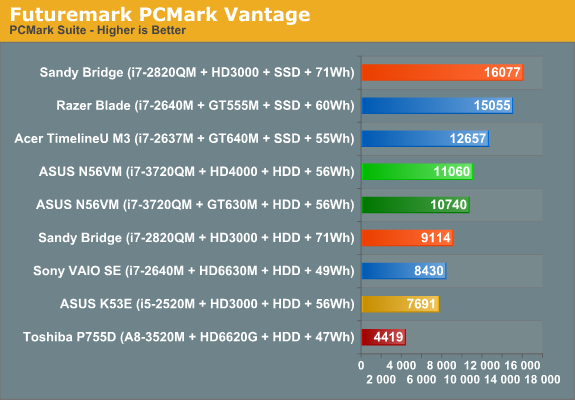
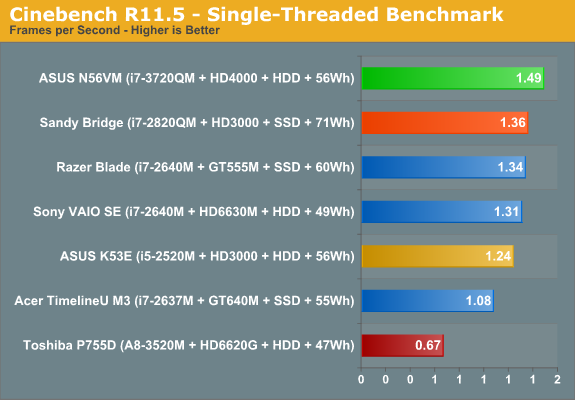
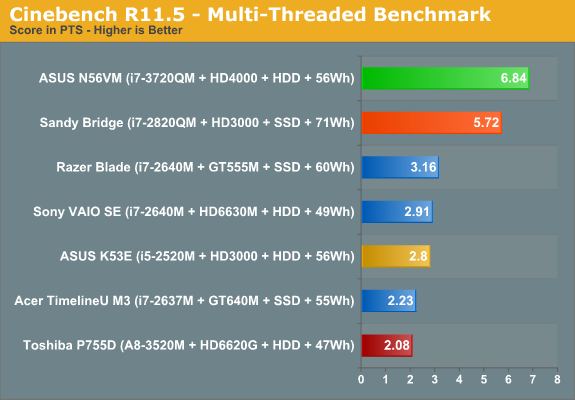

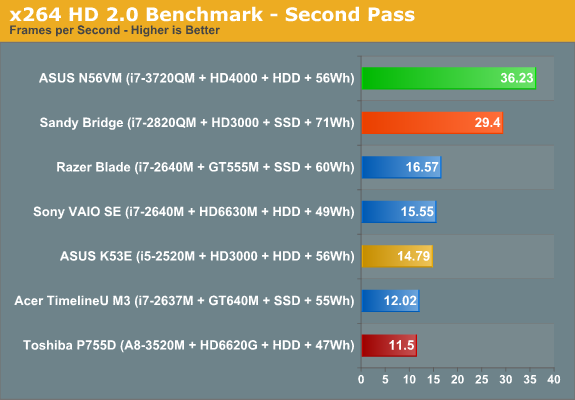
Where Sandy Bridge brought about a revolution in CPU performance for laptops, Ivy Bridge is a bit less dramatic. The i7-3720QM is certainly faster than the i7-2820QM (and it often beats an overclocked i7-2920XM as well!), but the difference ranges from “only” 10% in the single-threaded Cinebench 11.5 test to as much as 23% in the second x264 pass. You might be thinking that’s a little unkind of us, but keep in mind that the i7-2820QM destroyed the previous generation i7-820QM by anywhere from 50% to 125%, all while delivering substantially improved battery life. Regardless, the Ivy Bridge i7-3720QM is still the fastest mobile CPU we’ve ever tested, and it’s great to see such performance from the “mainstream quad-core” offering. Even so, if you were looking for the same sort of jump that we saw with Sandy Bridge you might be somewhat disappointed by the CPU results. For that, you'll have to wait for the next 22nm chip: Haswell.
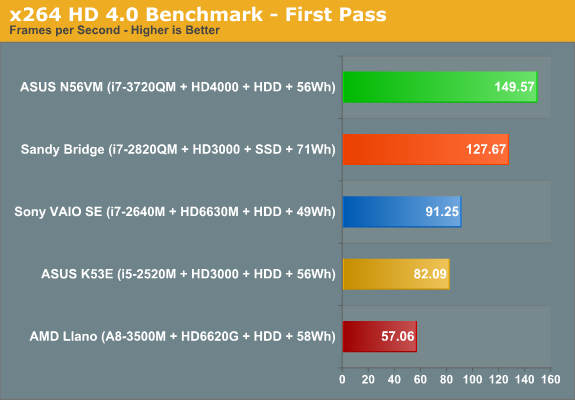
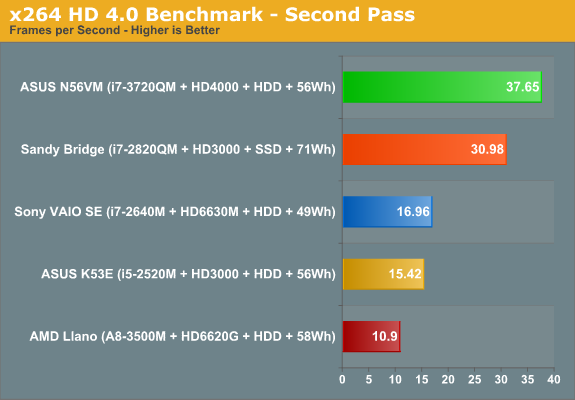
Update: We received a note asking about our x264 HD numbers. For laptop reviews, we've been using x264 HD 2.0 for the past couple of years just to stay consistent. Version 3.0 didn't really do much for performance that I could see (it was actually slower in many cases), and I wanted to be able to compare a large history of laptop CPUs. x264 HD 4.0 is a different matter; the second pass doesn't change things much, but the first pass is substantially faster. I've run it on all the laptops I currently have available and included the above chart for reference. As you can see, the first pass on Ivy Bridge posts an impressive 149.57 FPS—nearly 50% faster than the 2.0 benchmark—and most of the other CPUs see similar gains.










49 Comments
View All Comments
JarredWalton - Tuesday, May 1, 2012 - link
Ivy Bridge is technically capable of supporting three displays, but it needs three TMDS transceivers in the laptop (or on the desktop motherboard) to drive the displays simultaneously. Some laptop makers will likely save $0.25 or whatever by only including two, but others will certainly include the full triple head support.JarredWalton - Thursday, May 10, 2012 - link
Just a quick correction, in case anyone is wondering:For triple displays, Ivy Bridge needs to run TWO of the displays off of DisplayPort, and the other can be LVDS/VGA/HDMI/DVI. I can tell you exactly how many laptops I've seen with dual DP outputs: zero. Anyway, it's an OEM decision, and I'm skeptical we'll see 2xDP any time soon.
JarredWalton - Tuesday, April 24, 2012 - link
"I'm not sure what your point is, at all"? You cannot be serious. Either you have no understanding of thermodynamics, or you're just an anonymous Internet troll. I don't know what your problem is, rarson, but your comments on all the Ivy Bridge articles today are the same FUD with nothing to back it up.Ivy Bridge specifications allow for internal temperatures of up to 100C, just like most other Intel chips. At maximum load the chip in the N56VM hits 89C, but it's doing that with the fan hardly running at all and generating almost no noise compared to other laptops. Is that so hard to understand? A dual-core Sandy Bridge i7-2640M in the VAIO SE hits higher temperatures while generating more noise. I guess that means Sandy Bridge is a hot chip in your distorted world view? But that would be wrong as well. The reality is that the VAIO SE runs hot and loud because of the way Sony designed the laptop, and the N56VM runs hot and quiet because of the way ASUS designed the laptop.
The simple fact is Ivy Bridge in this laptop runs faster than Sandy Bridge in other laptops, even at higher temperatures than some laptops that we've seen. There was a conscious decision to let internal CPU temperatures get higher instead of running the fans faster and creating more noise. If the fan were generating 40dB of noise, I can guarantee that the chip temperature wouldn't be 89C under load. Again, this is simple thermodynamics. Is that so difficult to understand?
How do we determine what Ivy Bridge temperatures are like "in general"? How do you know that it's a "hot chip"? You don't, so you're just pulling stuff out of the air and making blanket statements that have no substance. It seems you either work for AMD and think you're doing them a favor with these comments (you're not), or you have a vendetta against Intel and you're hoping to make people in general think Ivy Bridge is bad just because you say so (it's not).
mtoma - Tuesday, April 24, 2012 - link
I really don't want to play dumb - but if I get an honest answer I'll be pleased: Jarred said that the panel used in Asus N56VM is an LG LP156WF1. OK - how can I find the display type in a specific laptop? I have a Lenovo T61 and... I need help. I want to know the manufacturer, display type, viewing angles. Thanks!JarredWalton - Tuesday, April 24, 2012 - link
I use Astra32 (www.astra32.com), a free utility that will usually report the monitor type. However, if the OEM chooses to overwrite the information in the LCD firmware, you'll get basically a meaningless code. You can also look at LaptopScreen.com and see if they have the information/screen you need (http://www.laptopscreen.com/English/model/IBM-Leno...leovande321 - Wednesday, May 15, 2013 - link
AUO 10.1 "SD + B101EVT03.2 1280X800 Matte Laptop Screen Grade A +I hope to help you!!!
AUO BOE CMO CPT IVO 10.1 14.0 15.6 LED CCFL whoalresell
Wholesale Laptop Screens www.globalresell.com
Spunjji - Thursday, April 26, 2012 - link
Calm down there. His comment is pointing out that measuring the temperatures of this laptop will tell you nothing about how hot mobile Ivy Bridge is as a platform. We need more information. It looks like it's not as cool as Intel marketing want everyone to believe, but we just don't know yet.JarredWalton - Thursday, April 26, 2012 - link
The real heart of the matter is that more performance (IVB) just got stuffed into less space. 22nm probably wasn't enough to dramatically reduce voltages and thus power, so the internal core temperatures are likely higher than SNB in many cases, even though maximum power draw may have gone down.For the desktop, that's more of a concern, especially if you want to overclock. For a laptop, as long as the laptop doesn't get noisy and runs stable, I have no problem with the tradeoff being made, and I suspect it's only a temporary issue. By the time ULV and dual-core IVB ship, 22nm will be a bit more mature and have a few more kinks ironed out.
leovande321 - Wednesday, May 15, 2013 - link
AUO 10.1 "SD + B101EVT03.2 1280X800 Matte Laptop Screen Grade A +I hope to help you!!!
AUO BOE CMO CPT IVO 10.1 14.0 15.6 LED CCFL whoalresell
Wholesale Laptop Screens www.globalresell.com
raghu78 - Wednesday, May 2, 2012 - link
Even though you have mentioned that 45w Llano would have improved the gaming performance it would have been better to include such a configuration in your testing. Given that you were testing a 45w high end next gen core i7 product which itself skews the balance in Intel's favour given the vast difference in CPU processing capability the least you could have done was put a similar wattage AMD Llano SKU. The result would be that other than Batman and Skyrim the rest would all be better on HD 6620G. As they say "a picture is worth a thousand words ". All your charts cannot be undone by a small note at the end of the charts. The damage has been done.This is my opinion that objective comparisons can only be made under similar parameters. Its even more critical in the notebook market which have strict thermal restrictions. The desktop market is slightly less restrictive except for HTPCs which need 65w or lesser processors. When the comparisons for Trinity 35w are made it should be against 35w Ivybridge core i3 and core i5. By benching a ivybridge core i7 with a 45w rating and comparing with a Trinity 35w we aren't making a fair and objective comparison. Also the fact that the ivybridge core i7 and trinity are not in the same price segment makes things worse. I hope my comments are not taken negatively.